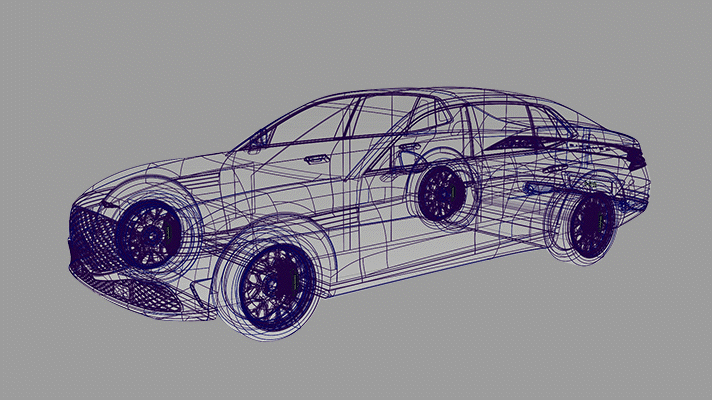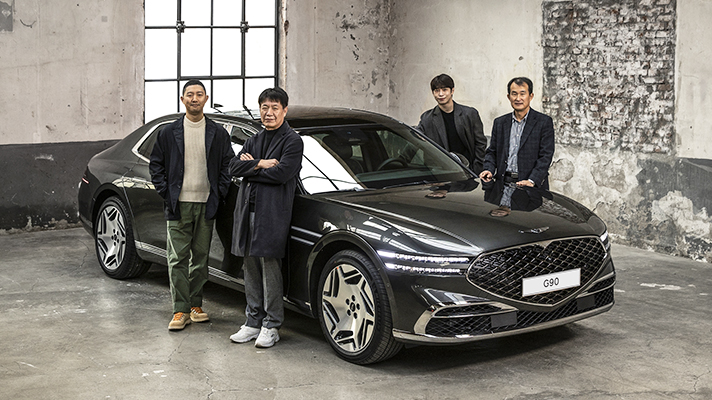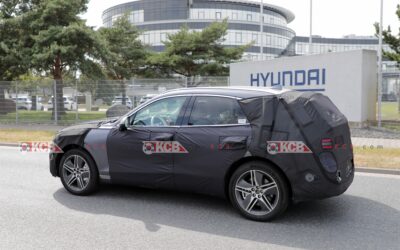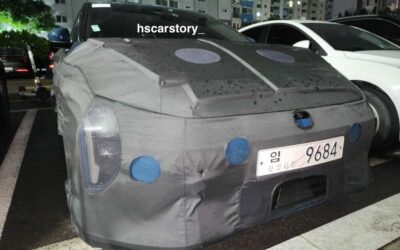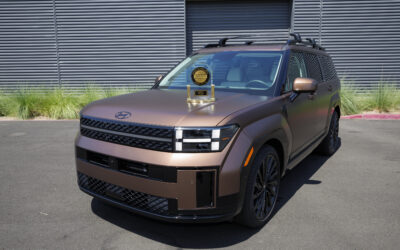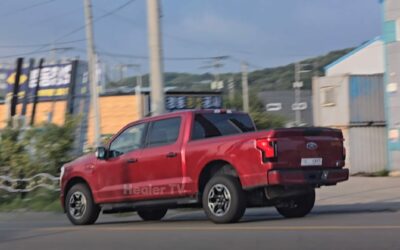The Genesis G90 flagship was born with a more elegant and dynamic look than any other Genesis. This result was possible thanks to the efforts of several people. Among them, the digital design team, which created 3D digital models, played a major role in allowing the 2D designs completed by interior and exterior styling designers to lead to mass production designs.
It was because digital design allowed them to focus more on improving the design perfection of the G90 by optimizing the development process and increasing efficiency.
But the process was not easy. There were many unconventional and dramatic design elements in the interior and exterior of the G90, so it was difficult to maintain it until mass production. Nevertheless, the G90 was able to appear before us as it is today thanks to the efforts of several digital designers who acted as a link between styling and design.
We talked about the digital design process with Se-bok Cheon and Chang-ha Lee of Hyundai Digital Design Team, who improved the exterior design of the G90, and Han-cheol Lee and Dam Park of Hyundai Digital Design Team, who meticulously finished the interior design.
The design of the G90 was completed thanks to the efforts of digital designers connecting styling and design in an invisible place.
Q. I wonder what role each individual played in the digital design process of the G90.
Hancheol Lee Senior Researcher | The work of a digital designer can be broadly classified into two stages. First, there is the CAS (Computer Aided Styling) stage, which is a preceding 3D digital modeling that converts the initial design ideas and concepts of interior and exterior designers into digital data focusing on styling. Put simply, it is the process of changing the flat design sketch drawn by styling designers into a three-dimensional form in a virtual space called digital. At this stage, we digitally embodied the interior design idea of the G90 together with the interior styling designer. Since this process is included in the initial design stage, design ideas are converted into digital data by focusing on styling rather than design conditions or regulations required for mass production.
Changha Lee Researcher | Like Senior Researcher Hancheol Lee, he was responsible for the digital design of the G90 in the CAS stage. Specifically, the ideas selected in the initial stage of the exterior design of the G90 were organized and digitized together with the styling designer in charge. There are things that can be expressed in drawings or sketches during the car design process, but are difficult to implement in reality. One of our main tasks is to check through various 3D digital data on how to express the designer’s intentions in a real car. In addition, it is our responsibility to properly apply numerous requirements such as adjustment of the impact angle to improve vehicle stability, setting up a parting line for smooth mass production, and application of minimum curve values, without changing the design.
Dam Park Senior Researcher | Another job of a digital designer is CAD (Computer Aided Designing), which creates digital data for actual mass production in accordance with various laws and design requirements based on the digital data created in the CAS stage. In the CAS stage, the focus was on styling, i.e., making the car look good, but in the CAD stage, a kind of digital drawing is created by reflecting realistic elements to make a real car. In my case, I was responsible for the interior design of the G90 during the CAD stage. In order to improve the interior design quality of the G90, the design completeness was improved very precisely based on the CAS data, and the conditions of design, regulations, and production technology were checked and applied to the interior design data.
Cheon Se-bok Senior Researcher | In the CAD stage, the exterior styling design data was managed to satisfy the conditions for mass production. A lot of coordination and consultation is required before the data is transferred to the final mass production, and he mainly played that role. In the case of styling design, shape maintenance is the most important thing. On the other hand, in design, it is often difficult to maintain the design shape due to various laws, the application of new technologies, the relationship between items, materials and properties, etc. So, the link between styling and design is important. There were many difficulties in this process, but we discussed countless times and found a better way to achieve the final result.
Researcher Changha Lee, who was in charge of the exterior digital design of the G90, said that he put a lot of effort into each face to improve the design perfection.
Q. Given that the G90 is the flagship model of Genesis, it must have been special in many ways in digital design.
Changha Lee Researcher | It is the same when designing other cars, but when working on the G90, it seems that he paid special attention to the flow of lines and planes, which are the basics of design perfection. Above all, as the flagship sedan of Genesis, the G90 flows across the body from start to finish without interrupting the side character lines and planes based on a large and long body.
The perfection of this aspect comes from the proper relationship of the lines that make up it. Numerous lines exist in automobiles, such as character lines, parting lines, and side glass lines. When each line has similar properties and maintains an appropriate flow, the surfaces placed on it inherit the properties of the lines as they are and express a clean reflection (reflective surface).
Many digital designers, including myself, have worked to improve the perfection of all the lines and surfaces that make up the G90 and to keep the reflection flowing smoothly, and I think that resulted in good results. Above all, it seems that these characteristics do not disappear in the various stages of design development, but are well fused and organized with the overall design elements, becoming one of the design characteristics of the G90.
The double-row lamp, one of the Genesis design features, is also well applied to the design characteristics of the G90. The two-line lamp, which creates a lamp area by projecting delicate and thin lines on the clean body surface, is a characteristic of all current Genesis models. In order to make this lamp design look the same from any angle, a lot of time and effort was put into refining the body surface.
Se-bok Cheon, a senior researcher in charge of the exterior digital design of the G90, said that he put a lot of effort into making the design of the point where the hood, grille and headlamp meet up to mass production.
Q. As the G90 is a special flagship model, the process of completing the most striking exterior design must have been special. What would it be like in reality?
Cheon Se-bok Senior Researcher | The exterior of the G90 has many unique designs that have not been seen in Genesis until now. This shows how much effort the styling designers, Hancheol Lee, and Researcher Changha Lee, etc. put in to complete the cool design in the CAS stage. As a result, further improvements and modifications were frequent in the digital design phase for design. In the initial design stage, it was decided that it was okay and proceeded, but there were many additional improvements during the detailed design process. Also, since it is a large sedan with a relatively large body size, there were many unexpected difficulties in connecting small details into one.
Typical examples are the hood in the shape of a clamshell like a giant seashell and the trunk lid design with a large angle. I especially remember the process of determining the final design of the point where the hood meets the grill and headlamps. While maintaining the unique shape of the hood, which boasts the largest area among Genesis mass-produced cars, it was necessary to seamlessly connect the points where it meets the grill and headlamps, but there were many variables in the design.
For example, the hood is made with a press mold, while the grill and headlamp are made with an injection mold. Therefore, it was necessary to maintain a consistent design while considering the different molding conditions and assembly directions of each part. Above all, it was necessary to maintain the curve value at the point where each part meets while meeting the mass production standards. Standards referred to here include aerodynamic performance that lowers air resistance and pedestrian safety standards. It is the role of our digital designers to carry out the elegant design proposed in the styling stage to mass production, and a lot of people put in a lot of effort to keep the original design idea to the end.
Senior researcher Han-cheol Lee, who was in charge of the interior digital design of the G90, emphasizes that he paid attention to completing one leather garnish on both sides of the instrument panel.
Q. The interior design of the G90 is just as gorgeous and elegant as the exterior. Since it’s a flagship sedan, I think they paid more attention to the interior design, but I’m curious how it would have been in reality.
Hancheol Lee Senior Researcher | The interior design of the G90 has many shapes that were difficult to find in existing cars. Styling designers did not give up on this form because they had a great desire to realize the brilliant ideas of the designers.
In particular, the wing-shaped leather garnish that rises on both sides of the instrument panel is a form that has not been seen in existing cars, and it went through a lot of trial and error until it was trimmed to fit into the G90.
Above all, it was not easy to insert the button module because the width of this part was narrower than expected. A typical example is the process of inserting an angled module while maintaining the slim flow or tension of the line requested by styling designers. To complete this part, we first checked the functions required for the design element, and then selected the smallest available module.
Then, they received the design data of the module and placed them in the design that was developed earlier, trying to find the optimal position and angle. Various attempts were made to find the optimal shape to wrap the module, and in the end, we were able to find the shape and location for the optimal design while satisfying the design needs.
Senior Researcher Dam Park, who was in charge of the interior digital design of the G90, said that there was a lot of trouble at the point where the front hood and the interior crash pad meet.
Dam Park Senior Researcher | In general, the shape seen when looking at the interior through the window from the outside of the car may be different from the shape seen when viewing the outside through the window from the inside of the vehicle. In order to minimize the occurrence of such problems, great care was taken not to feel awkward at the point where the belt line of the G90 exterior and the interior door trim are connected, and the point where the front hood and interior crash pad meet.
In particular, I had to overcome many mountains to complete the crash pad like now. I wanted to give the crash pad a rich volume, but there were a couple of conditions to consider, such as the distance from the windshield and the deployment of the airbag. There was a lot of trial and error because I had to consider the overall connectivity with the hood. The same is true for the implementation of a unique and unified shape that extends from the crash pad through the front center console to the rear center console. When completing the air conditioning panel, the design image was implemented in consideration of the location of the emergency light switch, usability of the cup holder, and the location of other switches. In order to complete this harmonious detail, it repeated the work of checking and improving digital design data, physical models, and prototypes in several stages. Above all, the styling designers and the desire to complete the elegant interior design of the G90, which was completed in the CAS stage, were great, so it seems that we were able to mass-produce it as it is now with a little more effort.
Digital design minimizes time and cost by digitizing various conditions before a great style is put into actual mass production.
Q. With the use of 3D data called digital design, it seems that the design evaluation process itself has changed a lot. What would it be like in reality?
Hancheol Lee Senior Researcher | Each modeling technique has different strengths and weaknesses. Therefore, I think that the optimal design process can be established if the modeling timing is well coordinated and parallel. Although digital models have many advantages in terms of time and process, in the end there are some things that you have to see in the real world.
Even if VR (Virtual Reality) and HMD (Head Mounted Display) based on 3D digital data are used, some differences may occur from reality. Therefore, the design of the G90, which was initially data-based, was verified through actual models such as 3D printing and clay. Then, by repeating the process of modifying data again, the design intent and quality were improved. As such, the G90 is a car completed by applying an efficient design process by taking advantage of the advantages of each method.
Digital data using 3D data is increasing the efficiency in the evaluation process.
Dam Park Senior Researcher | Digital makes a car in a virtual space, but using, driving, and feeling the car is done in real space, not in virtual space. All situations are reviewed with digital data in virtual space, but there are also clear differences between virtual space and reality. In real space, people move, look at the car, feel the touch, and assemble parts to complete it.
These things are impossible in the digital virtual space. So, in the G90 design development stage, I made a real model, found differences that could not be felt in the digital model, and improved the design perfection with luxurious details.
Lee Han-cheol, Park Dam, Cheon Se-bok, senior researcher, and Lee Chang-ha (from left), who led the splendid styling to design, say they want many people to feel the dignity and value of the G90.
Q. I wonder how the G90, which was completed through a difficult process, would like to approach customers.
Cheon Se-bok Senior Researcher | Since the G90 is the flagship model of Genesis, it was more burdensome than other models. However, it was a project that was made with a sense of responsibility to maintain the dignity as a representative car that rises to the ranks of world-class luxury cars. I want people who buy the G90 to feel this quality in various parts.
Changha Lee Researcher | I remember being thrilled to be part of the Genesis flagship sedan, the G90. I took part in the design with the joy and passion of that time, and it is a project that many people, including myself, put the heart into. The best elements of Genesis are included in every part, and as a result, results that can be presented anywhere in the world are worthy of praise. I think that many people will feel such pride naturally when they experience this car.
Dam Park Senior Researcher | It is a car made with so much effort that you can remember all the data created during the digital design process. I want customers to feel that it is a top-of-the-line car, while the G90 receives a lot of love for its high-quality design.
Hancheol Lee Senior Researcher | The G90 is Hyundai Motor Group’s best car. So, whether it is shopper-driven or owner-driven, we did our best to ensure that users experience the optimal environment by placing appropriate technologies in the right place. In particular, in the case of interior design, the paradigm has recently changed from moving to living. I hope that many people will experience firsthand the new luxury flagship sedan that has been polished like a piece of jewelry.
Source: HMG

